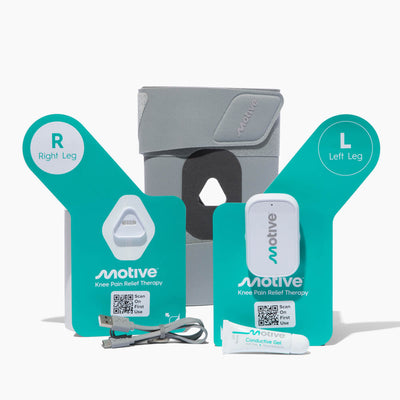
Knee arthritis, especially osteoarthritis of the knee, is a condition that affects millions of people around the world, causing joint pain, stiffness, and reduced mobility. These symptoms make daily activities like walking or climbing stairs a challenge.
Doing regular exercises can help manage your knee arthritis pain by focusing on strengthening the quadriceps, hamstrings, and other leg muscles. With this, you can reduce arthritis pain, improve joint function, achieve weight loss, and continue to do your daily activities.
In this article, we will review specific strategies and discuss how to incorporate Motive into your arthritis management plan.
Understanding Knee Arthritis
Knee arthritis is a degenerative condition that affects the knee joint.

Source: OrthoInfo
The two most common types are:
- Osteoarthritis — the general wear and tear of cartilage that develops over time due to aging, repetitive stress on the knee, or previous injuries
- Rheumatoid arthritis — an autoimmune disorder that causes inflammation in the joints by attacking healthy joint tissue
Both can make everyday activities like walking, climbing stairs or even standing for long periods challenging.
Exercise is a powerful tool for knee arthritis. By doing regular physical activity you can strengthen the muscles around the knee, like quadriceps and hamstrings that help to stabilize the joint and reduce pain.
Exercise also improves range of motion, increases flexibility, and overall joint health making it easier to maintain mobility and continue with daily activities.
Benefits of Exercise for Knee Arthritis
Physical therapy and exercise has many physical and mental benefits for people with knee arthritis. Here are the many ways it can benefit you.
Physical Benefits
- Reduced Inflammation: Exercise reduces inflammation in the knee joint by increasing circulation around the thigh muscles and reducing the build-up of inflammatory substances. This means less pain and stiffness.
- Increased Range of Motion: Gentle stretching and strengthening exercises increase flexibility and maintain joint function so you can move freely with less discomfort. This is essential for daily activities like walking and climbing stairs.
- Muscle Strengthening: Strengthening the quadriceps, hamstrings, and other leg muscles increases stability to the knee joint reducing the strain on the affected area. Stronger muscles also help to prevent further joint damage.
Mental Benefits
- Better Mood and Wellbeing: Physical activity releases endorphins, the body’s natural mood boosters, which helps to combat the frustration and mental lows that come with chronic pain conditions like knee arthritis.
- Increased Confidence: As you get stronger and more mobile, you may feel more confident in managing your knee arthritis and doing physical activities, so you can live a more active and fulfilling life.
Safe and Effective Exercises for Knee Arthritis
For people with knee arthritis, choosing the right arthritis exercises is a very important part of the process to manage pain and improve mobility without causing further joint damage.
The general rule of thumb is that low-impact exercises have the biggest impactas they reduce stress on the knee joints while still providing physical benefits.
Here are some of the safe and best exercises for knee arthritis so you can build strength and improve your overall wellness.
1. Swimming
Swimming is a full-body workout that doesn’t put pressure on the knees. The water supports your body weight making movements easier and less painful.
Modification Tips: Start with gentle strokes like backstroke or freestyle. If full swimming is too challenging, walk or do leg lifts in the shallow end of the pool.
2. Cycling
Cycling, be it on a stationary bike or outdoors, is great for strengthening the quadriceps, hamstrings and for overall cardiovascular health. It’s a low impact exercise that maintains joint flexibility.
Modification Tips: Adjust the bike seat height so your legs can extend comfortably without overstretching. Start with short sessions and gradually increase as you build up endurance.
3. Water Aerobics
Water aerobics combines the benefits of aerobic exercise with the joint-friendly environment of water. It improves cardiovascular fitness, flexibility, and muscle strength, all without putting stress on the knees.
Modification Tips: If you’re having a flare-up of arthritis pain, do slower movements. You can also use water weights or resistance bands to add more intensity, based on your comfort level.
4. Gentle Stretching
Gentle stretches focusing on your hamstrings, quadriceps, and calf muscles help with flexibility and relieve muscle tightness around the knee joint. They can help improve your range of motion and reduce stiffness.
Modification Tips: Do stretches while seated or lying down if standing is uncomfortable. Hold each stretch for 20-30 seconds and make sure you don’t bounce which can irritate the joint.
5. Strengthening Exercises
Straight leg raises and gentle step-ups help strengthen the leg muscles that support the knee joint. Strengthening these muscles helps alleviate knee pain by reducing the stress and pressure placed on the joint.
Modification Tips: Use a chair or railing for support when doing step-ups or other weight bearing exercises. Start with fewer repetitions and increase as you get stronger.
Incorporating Motive Knee into Your Exercise Routine
Motive Knee is a revolutionary, FDA-cleared device that complements your exercise routine and helps you manage your knee arthritis by strengthening the muscles around the knee joint, reducing pain, and improving mobility.
Quadriceps support the knee joints, if these muscles are weak you may experience worse knee arthritis pain. Motive Knee targets and strengthens these muscles to reduce the load on your knee and improve joint stability.
By focusing on muscle building, Motive Knee addresses one of the main causes of knee pain: muscle weakness. Consistent use will give you noticeable pain reduction and make it easier to be active and do daily activities.
Here are some ways you can integrate Motive Knee into your exercise routine:
- Pre-Exercise Warm-Up: Use Motive as part of your warm-up to activate and prepare your muscles before doing low impact exercises like swimming, cycling or water aerobics. This will improve your performance and reduce the risk of injury.
- Post-Exercise Recovery: After your exercise routine, Motive can aid in muscle recovery. This will help reduce post exercise soreness and make your muscles ready for the next workout.
- Consistency is Key: For best results, use Motive daily. Whether you’re doing strengthening exercises or just managing your knee pain throughout the day, regular use will give you long-term results for your knee health.
Tips for a Successful Exercise Routine
Exercising with knee arthritis can be tough but with the right approach, it can have a huge impact on your life.
Here are some tips to help you get started with a safe and effective exercise routine:
-
Start Slow and Gradually Increase Intensity: Start with gentle exercises that don’t put too much strain on your joints, like stretching or low impact activities like walking or water aerobics. Starting slow allows your body to adjust without putting unnecessary stress on your knees. As you get stronger and have more endurance, gradually increase the intensity and duration of your workouts. This ensures you don’t overdo it and will reduce the risk of injury.
Move Forward with Motive
Knee arthritis is challenging, but with the right approach, you can manage the pain and improve your mobility.
Incorporating Motive into your exercise program allows you to continue to strengthen the key knee muscles at home.
Now is the time to take control of your health.
Start by adding gentle exercises in your daily routine and see how Motive Knee can help your journey to pain relief and increased mobility.
Learn more about how Motive Knee can be part of your arthritis pain management plan.





